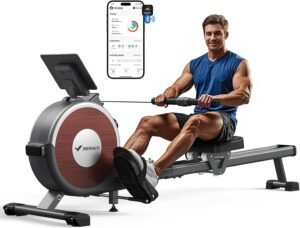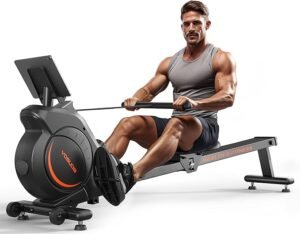When I decided to buy a rowing machine for my home gym, I thought I’d just pick one and be done. I didn’t expect to be faced with three completely different types of rowers: magnetic, air, and water.
At first, I had no idea what made them different. They all looked similar—seat, handle, footrests—but the more I dug in, the more I realized that each type delivers a very different experience. If you’re trying to figure out which one is right for you, this guide is going to help.
Let’s break down how each type works, what it feels like, and who it’s best suited for—based on what I’ve learned from real-world use.
Magnetic Rowing Machines
What They Are
Magnetic rowing machines use magnets to control resistance. When you adjust the dial or buttons, you’re changing the magnetic force against a flywheel, which makes it harder or easier to row.
My Experience
This was the first rower I owned. The main reason? It was quiet—like really quiet. I could row early in the morning while others were sleeping without disturbing anyone. Plus, it folded up nicely and fit in my small apartment.
Pros and Cons
The ride is smooth and predictable, which makes it great for beginners. But since the resistance doesn’t respond to your effort, it can feel a bit “flat” compared to other styles.
Best For
If you’re just getting started, have limited space, or need something apartment-friendly, a magnetic rower is a smart, low-hassle option.
Best Magnetic Rower
MERACH Q1S Magnetic Rowing Machine

This one’s our go-to for quiet, apartment-friendly workouts. It’s compact, whisper-smooth, and folds up neatly after use. The Bluetooth-enabled Merach app tracks your sessions and keeps things engaging.
Air Rowing Machines
What They Are
Air rowers use a fan to create resistance. The harder and faster you row, the more resistance you get. It’s a natural and dynamic system that responds instantly to your effort.
My Experience
I used an air rower at a gym and immediately noticed how much more challenging it felt. The resistance kicked in fast, and it felt more athletic and intense. The only downside was the noise—it’s not subtle. You’ll definitely hear the fan whirring with every stroke.
Pros and Cons
You get a great cardio workout, especially for interval training. But they’re louder and often bigger than magnetic rowers.
Best For
Great choice if you want something that pushes you harder the more you put into it. Ideal for HIIT, athletes, or anyone looking for that “gym-style” workout at home.
Best Air Rower

If you love the feel of real-time resistance and HIIT-style workouts, this one delivers. The harder you row, the tougher it gets. Plus, it folds up and handles heavier users well.
Water Rowing Machines
What They Are
Water rowers use real water in a tank to generate resistance. As you row, the paddles spin through the water, mimicking the feel of rowing on a lake or river.
My Experience
Trying one of these was a different kind of workout—calm, smooth, and satisfying. The whooshing sound of water added a meditative vibe to the session. It didn’t feel like a machine. It felt like I was actually rowing outside.
Pros and Cons
They offer the most realistic rowing feel and often come in beautiful wooden designs. But they’re heavier, need a bit of maintenance (like water treatment), and take up more space.
Best For
If you care about the experience as much as the workout and have a dedicated space for it, this is a great investment.
Best Water Rower

Looking for the most natural rowing feel? This machine offers the whoosh of real water, a beautiful design, app connectivity, and a 350 lb weight capacity all at an excellent value.
Rowing Machine Comparison Table
| Feature | Magnetic Rower | Air Rower | Water Rower |
|---|---|---|---|
| Resistance Type | Magnet-controlled | Fan-based, effort-driven | Water tank with paddles |
| Noise Level | Very quiet | Loud (fan noise) | Moderate (water swish) |
| Workout Feel | Smooth, consistent | Athletic, dynamic | Natural, fluid, realistic |
| Adjustability | Manual or digital levels | Changes based on effort | Changes based on effort |
| Maintenance | Very low | Low | Medium (clean or treated water) |
| Storage-Friendly | Often foldable | Usually large | Bulky, not foldable |
| Typical Price Range | $200 – $700 | $300 – $900 | $400 – $1,200+ |
| Best For | Beginners, small spaces | HIIT, cardio-focused users | Immersive home fitness |
So, Which One Should You Pick?
Here’s my honest answer: It depends on your goals, your space, and your vibe.
If you’re just starting out or you live in a smaller space, a magnetic rower is simple, quiet, and easy to manage.
If you want to train hard and don’t mind the noise, an air rower delivers a gym-quality workout that responds to your intensity.
And if you’re looking for a premium, natural rowing experience that feels almost like meditation, go for a water rower, as long as you have the room and don’t mind the upkeep.
Final Thoughts
I’ve spent time with each type of rower, and I can tell you there’s no one-size-fits-all answer. What matters most is consistency. The “perfect machine” won’t help if it just sits there collecting dust.
So, start with what works for your life right now. You can always upgrade later. For me, starting with a magnetic rower helped me build the habit. That habit mattered more than the machine.
If you’ve made it this far, you’re already ahead of most people. You’re doing the research. Now, it’s just about getting started.
Want to read Best Rowing Machines Under $500 – 2025 Tested & Reviewed

